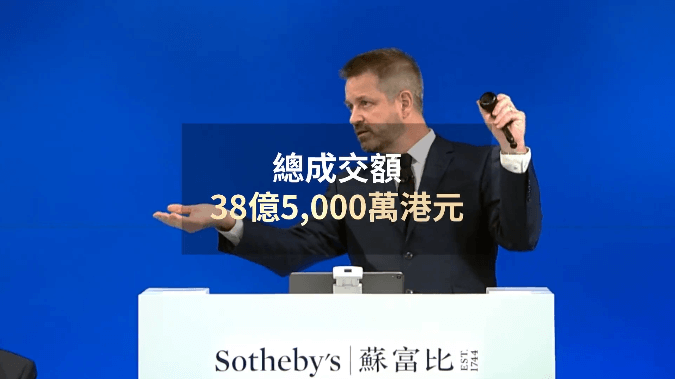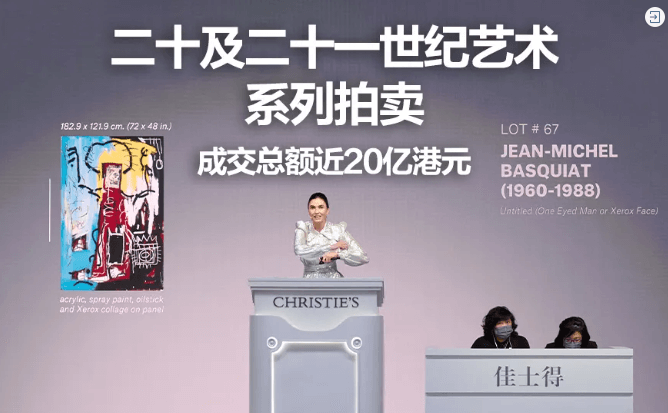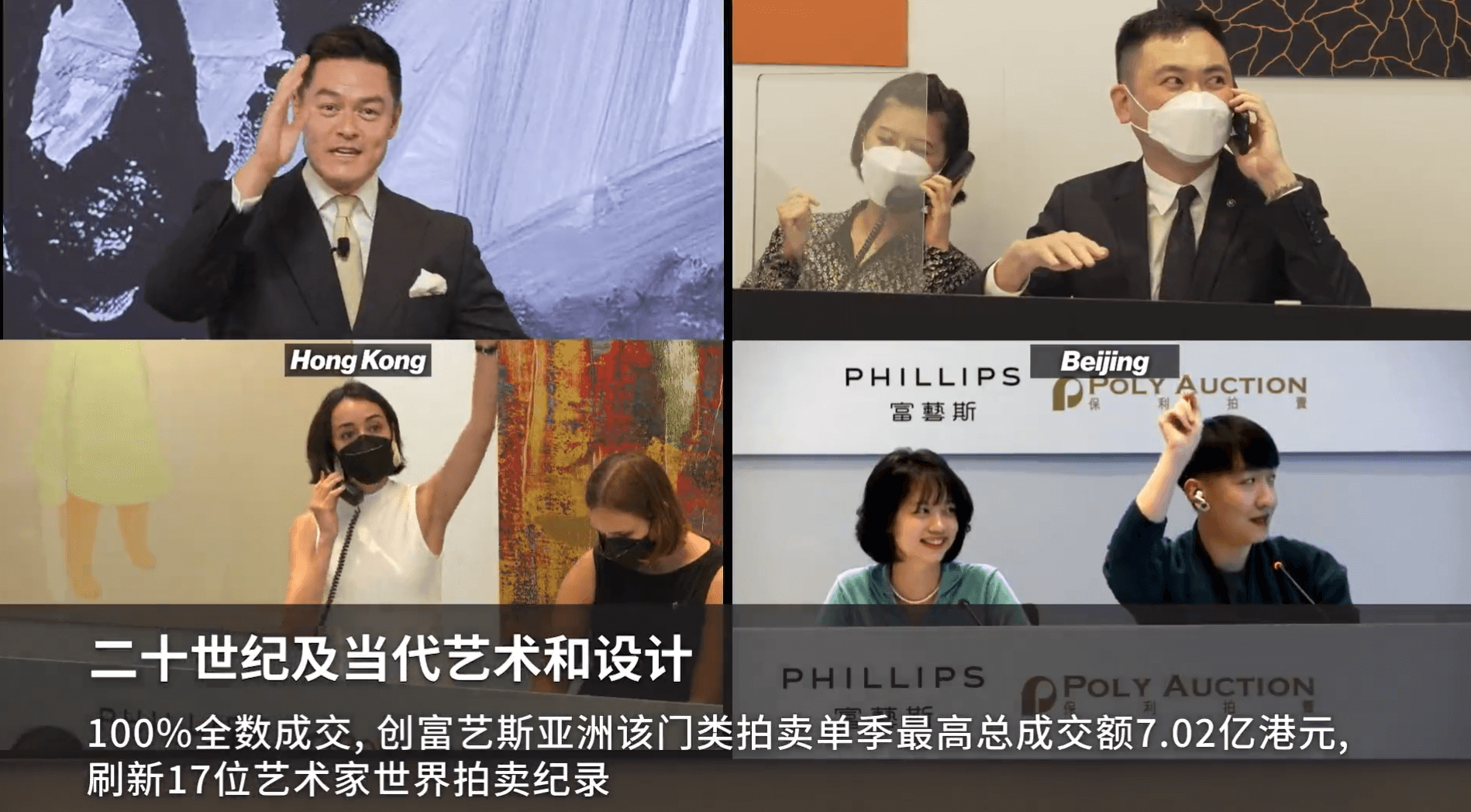[ArtPro Talk 2021 Spring Sale Summary I] 30% of artists broke their records in Asia, the Asian market has become a must-see for global artists
In June 2021, the spring sales of various auction houses has been successfully closed. According to the Artpro data, the transaction amount of spring auctions in 2021 has increased by nearly 20% compare to 2019 and 61% compare to 2020. The volume of the 2021 spring auction has increased by 25% relative to 2019 and 46% relative to 2020. The overall transaction data is growing rapidly. The auction houses have received satisfying result in the modern and contemporary sector. The total transaction of modern and contemporary art in Sotheby’s Hong Kong is HKD 2.25 billion. The total turnover of Christie’s Hong Kong is nearly HKD 2 billion, the joint spring auction of Poly Auction in Hong Kong and Phillip’s in Sri Lanka has sold HLD 702 million. These important achievements and the year-on-year growth in 2020 and 2019 has increased significantly. Behind these outstanding achievements in Hong Kong, what new changes and new trends have taken place in the Asian art market?
In this issue of ArtPro Talk, one of the 2021 spring auction summary forums "Trends and Changes in the Asian Art Market", we specially invited Guo Dongjie (hereinafter referred to as Guo Dongjie of Sotheby's), Director of Sotheby’s Asian Modern Art Department, and Zhuang Jun, the Senior Expert of the 10th and 21st Century Art Department of Christie’s Asia Pacific II (hereinafter referred to as Zhuang Jun of Christie’s). Li Meiling, the Art Director of Phillips 20th Century and Contemporary Art Department (hereinafter referred to as Li Meiling of Phillips), the Department Head Yu Qingmin of Modern and Contemporary Art Department in Poly Hong Kong Auction Co., Ltd. (hereinafter referred to as Yu Qingmin of Poly Hong Kong). Li Lin, the co-founder of ArtPro (hereinafter referred to as Li Lin of ArtPro). Media Xie Mu, the Vice President of ArtPro as the host. The have reviewed and summarized the trends and characteristics in the market of 2021 spring sale in Asia.

Host: First, We invited Li Lin, the co-founder of ArtPro, to talk about her overall view on the 2021 spring auction.
Li Lin of ArtPro: According to the statistics of ArtPro, after the adjustment in 2020, the art market in the first half of 2021 has been relatively active, compared to the turnover in 2019 and 2020, it has been rapidly increased. Except for the turnover and volume, there are two good signs. The first is the high-end art market: There were 109 pieces sold in the high-end art markets in 2019, 92 pieces sold in the high-end lots in 2020, and 83 pieces in 2021. Although only half a year, the number of high-end lots has reached 90% of 2020. From the perspective of turnover, the turnover in high-end market in 2020 was USD 2 billion, and the turnover in first half of 2021 has reached USD 2.048 billion.
Second is the situation of record-breaking artists in major auction cities around the world. In the four major auction cities, nearly 300 artists have broken records, including 35% in New York, 25% in Beijing, 20% in London, and 20% in Hong Kong. About 30% of the artists set their own auction records in Asian market.
On the whole, the Asian art market in the 2021 spring auction, whether it is the overall turnover and volume, or the turnover and volume of high-end artworks, is in a situation where both quantity and quality are increasing. We look forward to your experts bringing us more insights and analysis.
Host: All of you are veterans in the Hong Kong auction industry. Could you please share some opinions about how you looking at the overall performance of the Hong Kong market in the 2021 spring sales?
Guo Dongjie of Sotheby’s: First of all, on the behalf of Sotheby’s, I would like to thank ArtPro for the invitation. It is also a rare opportunity, to have all the representatives of major auction companies gathering. We have met in business for so many years, but we only have few opportunities to discuss together. Congratulations to everyone for the prosperous achievements of the entire art market in the first half of the year, and everyone's efforts have paid off. Although most of the us competitors, they are also teammates. Together, we are working hard for the art market in Asia.
Sotheby's performance in the first half of the year is also very good, the total turnover of 2021 spring auction of modern and contemporary is HKD 2.2 billion, plus "Jay Chou x Sotheby's" in June has gained another HKD 850 million, a total of more than HKD 3 billion, which has the significance of indicator in 2021. The entire modern and contemporary art sector is prosperous in all aspects, from the highest unit price, the intermediate market and the entry price are quiet strong.

First, the attention of the entire market and the cooperation in the capital chain are adequate; second, the practitioners of the industry are very mature in grasping the market of each state; third, customers have also undergone decades of educaing in the Asian market. Collectors from Southeast Asia, Japan, South Korea, and even Europe and United States have also begun to join, showing such prosperous circumstances.
Zhuang Jun of Christie’s: Although colleagues in the auction houses, we only had few opportunities to meet, we are still the most important players in the Asian auction market. Unlike the other three guests, I am from Shanghai. I was transferred from Shanghai to Hong Kong last year as the head of Asian Modern Art Department of Christie’s. The change in region allowed me to see the different performance of the market and also made me full of confidence in the Asian market. At the beginning of pandemic, everyone was worried. After last year’s spring and fall auctions, until the first half of this year, the confidence of art auction market and the trading market has greatly increased.

Li Meiling of Phillips: Compared with other auction companies, Phillips is relatively young and has only been in Hong Kong for five years. In the past five years, the progress is slowly. The growth from 2020 to 2021 is the fastest. Due to the pandemic, the entire economic structure has changed, and the generations of collectors have changed. We are also very excited to see the results in this year. The market performance is prosperous, every houses has received excellent result. Although there is competition, they are all healthy competition. The development of the entire market brings new artists, new directions and new trends.
Unprecedentedly, there were two white gloves in the day and evening sales of Phillips. On June 23, the evening sale in New York attracted many Asian collectors, it also a white glove sale. Not only in Hong Kong, the popularity in Asia has actually spread to auctions throughout the world.

Yu Qingmin of Poly Hong Kong: The boom in the Hong Kong market is an unprecedented achievement in more than ten years. The transaction rate of Poly Hong Kong spring sale has achieved 90%. The two auctions with Phillips are white gloves. In addition to the total turnover, our privately negotiated business, from Western Impressionism, modern, post-war and contemporary, has also reached new highs this year. We have witnessed the boom in the Asian market, the performance of funds was also very good, and everyone is optimistic and continue to prepare for the fall auctions.
Host: How is the layout of Eastern and Western artworks in the modern and contemporary art section, and what changes have been made to the overall plan?
Zhuang Jun of Christie’s: Christie’s has broken the boundaries globally. Since last year, there has been a big change. Impressionism and contemporary art have been integrated into one department, which is the 20th and 21st Century Art. After the Classicism there are no limitations. Christie's day and evening sales are the integration of Western modern art, Impressionism, Asian modern art, contemporary art and postwar art on a single platform. Since the 20th Century, artists have created in a completely different way, and this kind of global layout has started in Asia.
Asian area has long broken its boundaries. Around 2000, China, Japan, and South Korea were all separated. Now they have all been integrated into Asia one. In this state, Hong Kong’s borderlessness is different from New York and London. 75% of works of Christie’s Hong Kong were still sold in Asia. The options will take into account the preferences and market acceptance of Asian collectors, as well as strategies and steps to introduce Western art. Last year Christie’s Shanghai has first started, Christie’s has transferred relevant colleagues from Shanghai and London to Hong Kong and will promote it with a global strategy.
Guo Dongjie of Sotheby’s: From the perspective of market supply and demand, the market is the supplier. Our definition is more academic and detailed, such as China, Japan, Southeast Asia, United States, and Europe. The current situation is the other way around. Prosperity is more about planning auctions from the demand side. Asian collectors have got rid of the regional, temporal, or solidified concepts of the past.
Sotheby's artists from the West have rooted in Asia and Hong Kong for nearly 48 years, which is the earliest auction house to entering in Asia. From small pieces to masterpieces, the insight and vision of collectors have been cultivated, and the sense of distance between Asian collectors and Western artists has gradually disappeared. The powerful Asian collectors are able to appreciate both national art and Western art. Generally speaking, Asian collectors have reached a higher level of mentality, which also allows us practitioners in Asia to make bolder plans.
Host: In this year, the works of young artists have attracted fierce bidding, many Western young artists and artists of overseas have broken their auction records. Could you please talk about the changes of market in Asia regarding on the young artist?
Zhuang Jun of Christie’s: Artists born in the 1970s will be 50 years old by 2020. This is a period when artists are at their peak in physical strength and energy. It is natural for artists born in the 70s, 80s and 90s to receive attention, and it is the result of historical development. Whether in Asia, New York or London, there are more artists born in the 70s and 80s have become auction stars. There are several auction houses constantly breaking the auction records of various artists. This is the natural development, and we happen to encounter the trend at this point.
Yu Qingmin of Poly Hong Kong: A hero is made at the right time. The popularity of contemporary art is not new in recent years, and it is also the category that often breaks records at domestic and abroad. Contemporary art grows with collectors, which is closely related to our life, and to some extent reflects the spirit of the time. In addition, funds and popularity are relatively concentrated, that created star artists who constantly broke their record. Looking back at time, the Chinese contemporary artists in 2007 were all in their 30s and 40s. Zeng Fanzhi and Zhang Xiaogang have both reached the record, there is a process that can be compared to now. History often repeats itself, the times are constantly innovating, we can always discover new things, which is also the most interesting place in the collection circle. In the development of contemporary art, the academic status and endorsement behind it are more important. It is worth thinking about who can survive in this era.
Host: From the perspective of Hong Kong, young artists from all over the world are setting records here. How would you understand this phenomenon?
Guo Dongjie of Sotheby's: As an international art trading platform in Asia, Hong Kong plays a very important role. 150 years ago, France was the only art center in the world. To become a worldwide artist who conquered the world by conquering Paris. After the First World War, New York began to rise. In the 21st Century, one has conquered Paris and New York is not enough, the artist must have a place in Hong Kong, Beijing, and Shanghai in order to become global artist. This reflects the rise of the right to speak in Asia. Whether it is Asian or European and American artists, if they want to become a global artist, it is impossible to ignore the exposure and transaction records in Asia.
In the past, the world record for Asian artists was set in Hong Kong. In the past five or six years, the world record of international artists has been continuously set. Artists from Europe, America, Africa and all nationalities have broken records in Hong Kong. Hong Kong has been a heroic place for global artists. The discourse power has begun to balance with Europe and America, and the world is divided into three parts; the Hong Kong market is created by each auction company, and the healthy competition between us has made many artists shine through different channels. Although auction is a commercial platform, it is also the responsibility and honor of our time to expand the influence of artists and to impress the people at the social level.
Li Meiling of Phillips: From the data of the three international auctions at the end of last year, we can see that the achievements of Asian collectors are obvious to all. Half of Phillips’ top ten lots were purchased by Asian collectors. Hong Kong and Asia are important markets. We can also see auction companies moving larger and high-value works to Asia for auction; on the other hand, there are more European and American collectors requesting auctions in Hong Kong. It is obvious that Hong Kong will become more important in Asia and even internationally. Collectors from the Mainland China, Taiwan and Hong Kong are a market that we attach great importance to.
Host: What are the characteristics of collectors in their 40s and how are they different from collectors in their 60s in terms of purchase methods?
Yu Qingmin of Poly Hong Kong: Starting from 2012 and 2013, from the perspective of auction proportions, the age of collectors has gradually declined, and the proportion of young collectors in 2030 will get higher. On the other hand, we have to learn from them, because they have a much bolder way of looking at things, which is very different from the people in this industry.
Li Meiling of Phillips: The new collectors have a lot of ideas. Before, collectors looked at the market to buy things. From the perspective of private art museums, we will also find a clue. They are not only collecting favorite artworks, but also collecting this era. When we collect, we will also consider what the collectors need. We will find that they are very deep in communication and hope to achieve some social responsibility and set a good example from the collection. We are also following the progress of the collectors. The experts do not lead the collectors, but push us forward. The change of auction structure comes through such interaction.
Some young collectors also have art advisers. They all take collecting as a serious thing and work very hard. They also visit artists to get a deep understanding of their creative ideas. They are unburdened, brave and financially supported. What you can see right now is that they're taking a broader path. There's a lot of possibilities ahead and it's going to affect what happens in the market. I'm excited to see what happens next.
Jun Zhuang of Christie's: Young collectors will not only change the collection structure, but also influence the collectors of their parents' generation, which is impossible for us practitioners to do, the influence of children is very strong. From the perspective of collectors, the post-70s are more sensitive to their works and times. The works of these young artists are more attractive to young collectors. Ten years ago, an old collector shared with me that he could not ask his children to listen to him. He should respect young people and understand why they like younger and more international things. Only in this way there can be no generation gap between parents and children, which is also very important in the inheritance of art. Parental collectors leave art to their children in the hope that they will like it rather than resonate with it.
Guo Dongjie of Sotheby's: The new collectors are born in the 90s or even 00s. After a few years, they will be in their 20s and enter the adult stage. The idea of post-80s collectors is closer to that of post-70s. Post-90s collectors are obviously different from those born after 80s. Post-00 collectors are more avant-garde and pay attention to NFTs. The new generation born after 1990 and 2000 will allow avant-garde collecting behavior to develop. From the perspective of the future, new collectors are more professional and professional which is not the same as before the collector. Unlike the previous collectors, they take their own budget to invest, a new generation of collectors may do this as a career, a second job, they will seriously think about how to put the collection as a work to do, and grow up with the support of artists, to promote the development of industry, this will be a clear trend.
Guo Dongjie of Sotheby's: Sotheby's is always at the forefront. This is our pain and our happiness. I hope that while you are paying attention to us, we will lay a good position as a pioneer so that everyone can gain after hard work and keep the market boom. If there is news, we will inform you in a certain period of time.
Zhuang Jun of Christie’s: I hope everyone will pay more attention to the Christie’s official account and learn more about the latest developments.
Li Meiling of Phillips: The time of Phillips will be late, and we will continue the previous structure; in addition to blue-chip artists, we also try to help you find things by introducing artists who are very new but already have a base of collectors in the primary market. What you can't buy in the primary market, you can come to Phillips.
Yu Qingmin of Poly Hong Kong: Poly Hong Kong auctions are usually held with Sotheby's. I will share with you if there is any new cooperation in the future. Thank you for your support.
For more information about the global art market, please follow Artpro.
About ArtPro Talk
ArtPro Talk is an art topic discussion column planned and initiated by the ArtPro media team. It invited global art industry experts, senior practitioners, artists, collectors, etc., to discuss the cutting edge topics in the industry and the latest changes.









